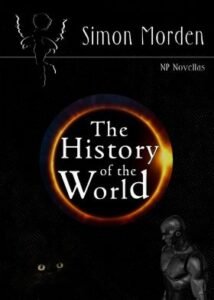The History Of The World by Simon Morden (book review).
‘The History Of The World’ by Simon Morden is a space opera sequel to his ‘At the Speed Of Light’ novella.
After rescuing the human PurLeeDah from her falling-apart lightspeed spaceship and its murderous crew, the sentient ramship, Corbyn, has returned to her home star system. He initially planned for her homeworld to fetch her from his ship because he cannot decelerate below his current near-lightspeed (0.999999999c, to be precise).
However, her homeworld’s civilisation has collapsed into primitive societies that know very little of mechanics and nothing of electromagnetism. So, Corbyn has to work out how to slow down enough to get her back onto her planet. There is a way, but it is very risky. He has no other choice but to use it if he is to fulfil his promise. Otherwise, her supplies will run out and her sleep tank will fail. He transits her home system again and again, in the hope of hitting something no bigger than a grain of sand. This will let him lose momentum so he can decelerate a tiny bit every time.
Each time he passes her world by, a bright blue light shines in its skies. The first such light changes a woman’s mind about bonding with a man. An insignificant event in itself. Yet Corbyn causes the blue light to shine every nineteen days. These events affect the redevelopment of the society. To the primitive civilisation he becomes known as the ‘Travelling God’, and the religion develops mathematics faster than expected by normal civilisation growth. Nevertheless, the civilisation’s development remains slow.
It becomes a race against time. Corbyn repeatedly checks his trajectory and supply calculations to see if he will make it in time. The priests check their own calculations to improve their understanding of the world and the ‘Travelling God’ to find out what it means for them.
This is a humongous theme to cover in a novella. As such, we only get snapshots of when, where and how Corbyn’s actions change her world’s progress. There is no chance of having any continuity of story on her world. Characters come and go. Their consequences live on and build one on the other. This is grand-scale world-building on a miniature palette.
‘The History Of The World’ is written in nine chapters, each containing a first section from Corbyn’s point of view and a second section on the trigger for the civilisation’s progress. When I came across the first chapter’s second section, I at first thought that it might be what PurLeeDah is dreaming of in her sleep tank. There was no clear signposting that the scene was actually taking place on her world. This was confusing until I got to the second chapter and realised what was going on.
Corbyn is the character that appears in all the chapters. Even he admits he is ‘a physics problem which required a physics solution’. While some emotions have been built into him for practical reasons, there is less than normal human characterisation. To me, this represents the reality of AIs, which gives an underlying authenticity to the story and plot.
‘The History Of The World’ left me with a lot of fascinating questions. The one that stands out is, why haven’t we seen more variations in civilisation development in science fiction? It is a speculative field ripe for exploration. This is a must-read novella for all those interested in having realism in their science fiction and exploring interesting ‘what if?’ questions.
Rosie Oliver
August 2025
(pub: Newcon Press, 2025. 140-page small A5 enlarged paperback. Price: £9.99 (UK). ISBN: 978-1-917735-10-0)
Check out the website: https://www.newconpress.co.uk/info/books.asp?authorID=105







